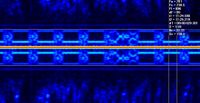UK AM Data System (UK-AMDS)
UK AMAmplitude Modulation Data System (UK-AMDS) was developed by BBC Research and Development in 1984 as a way to transmit low bitrate data on BBC Radio 4's LFLow Frequency (30-300 kHz) AMAmplitude Modulation carrier. Elements of this system were adopted into ETSIEuropean Telecommunications Standards Institute. An independent, not-for-profit, standardization organization in the telecommunications industry in Europe, developing global telecommunications standards.'s AMSS.
Click Here to Hear UK-AMDS Live at WebSDR Univ. of Twente[edit]
Characteristics[edit]
Digital data is transmitted by directly modulating the 198 kHzKiloHertz (kHz) 10^3 Hz carrier using bi-phase 22.5 degree PSKPhase-Shift Keying encoding. The PSKPhase-Shift Keying subcarriers are transmitted 25 HzHertz (Hz), unit of frequency, defined as one cycle per second (1 Hz). from the main AMAmplitude Modulation carrier. The PSKPhase-Shift Keying data signal operates at 50 symbols/sec, with data rate at 25bps from Manchester Encoding.
30 messages are transmitted per minute, each message having 50 bits of data. The total block length of each frame is 50 bits. 2 seconds = 1 block = 50 bits.
The BBC header of each block consists of 6 bits. The first bit is a fixed logic 1 bit that is used for synchronization. The following 4 bits of the BBC header represent the Block Application Code, with codes 0-15. This allows for 16 possible data channels. For example, one data channel is used to transmit an accurate time code. Another channel is used by UK electricity companies for switching domestic storage heaters and setting off-peak electricity tariffs.
The next 32 bits contains the user data payload. Following the 32 bits, there is a 13 bit CRC tail, which completes the 50 bit block.
All blocks transmit their most significant bit first. Thus, the last bit transmitted in a block has weight 2^0. The data transmission is fully synchronous and there are no gaps between blocks.
Samples[edit]
| Full AMDS | PSKPhase-Shift Keying Sideband |
|---|---|
Analysis[edit]
Analysis of the waveform was done to verify parameters, such as bandwidth, baudrate (symbol rate), and phase plane specifications.
Frequencies[edit]
UK-AMDS is currently broadcasted on 198 kHzKiloHertz (kHz) 10^3 Hz on BBC's Radio 4 Long Wave Transmitters in Droitwich, Westerglen, and Burghead. All 3 broadcast on the same frequency.
- Wikipedia Droitwich Transmitting Station - 500 kW | Location on Google Maps
- Wikipedia Westerglen Transmitting Station - 50 kW | Location on Google Maps
- Wikipedia Burghead Transmitting Station - 50 kW | Location on Google Maps
Decoding Software[edit]
Additional Links[edit]
- UK Radio Teleswitch Services
- Alan Cordwell UK Teleswitch
- Wikipedia Radio Teleswitch
- Wikipedia Droitwich Transmitting Station
- Wikipedia Westerglen Transmitting Station
- Wikipedia Burghead Transmitting Station
- BBC Research Department: Specification of BBC phase-modulated transmissions on long-wave - 1984








